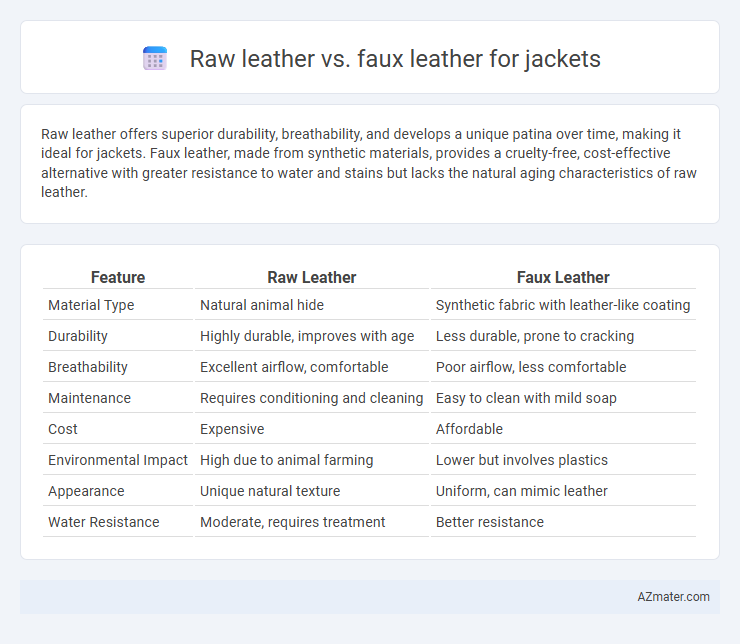Raw leather offers superior durability, breathability, and develops a unique patina over time, making it ideal for jackets. Faux leather, made from synthetic materials, provides a cruelty-free, cost-effective alternative with greater resistance to water and stains but lacks the natural aging characteristics of raw leather.
Table of Comparison
| Feature | Raw Leather | Faux Leather |
|---|---|---|
| Material Type | Natural animal hide | Synthetic fabric with leather-like coating |
| Durability | Highly durable, improves with age | Less durable, prone to cracking |
| Breathability | Excellent airflow, comfortable | Poor airflow, less comfortable |
| Maintenance | Requires conditioning and cleaning | Easy to clean with mild soap |
| Cost | Expensive | Affordable |
| Environmental Impact | High due to animal farming | Lower but involves plastics |
| Appearance | Unique natural texture | Uniform, can mimic leather |
| Water Resistance | Moderate, requires treatment | Better resistance |
Introduction to Raw Leather and Faux Leather
Raw leather, derived from tanned animal hides, boasts natural durability, breathability, and a unique texture that improves with age, making it a premium choice for jackets. Faux leather, crafted from synthetic materials like polyurethane, offers a cruelty-free, affordable alternative with water resistance and easy maintenance. Understanding these distinctions helps consumers select jackets that meet their style, ethical preferences, and functional needs.
Key Differences Between Raw and Faux Leather
Raw leather, also known as genuine leather, is made from animal hides and features a natural grain that provides durability, breathability, and a unique aging process, while faux leather is a synthetic material designed to mimic the appearance of real leather, often made from polyurethane or polyvinyl chloride (PVC). Raw leather jackets typically offer superior longevity and develop a patina over time, whereas faux leather jackets are more affordable, water-resistant, and easier to maintain but may crack or peel with extended use. The choice between raw and faux leather for jackets largely depends on factors such as budget, ethical considerations, maintenance preferences, and desired texture and lifespan.
Durability: Which Material Lasts Longer?
Raw leather, crafted from natural animal hides, offers superior durability due to its dense fiber structure and resistance to wear, often lasting decades with proper care. Faux leather, made from synthetic materials like polyurethane, generally exhibits less longevity, prone to cracking and peeling after a few years of regular use. For jacket longevity, raw leather remains the preferred choice, especially in demanding conditions where durability is paramount.
Comfort and Breathability Comparison
Raw leather offers superior breathability due to its natural pores, allowing better air circulation and moisture absorption, making it more comfortable for extended wear. Faux leather, typically made from synthetic materials like polyurethane, lacks these natural pores, resulting in reduced breathability and potential discomfort, especially in warm conditions. The natural fibers in raw leather also adapt to body temperature, enhancing comfort, whereas faux leather can retain heat and cause sweating.
Appearance and Style: Visual Appeal
Raw leather offers a rich, natural texture with unique grain patterns and a deep, authentic color that enhances the classic, rugged style of jackets. Faux leather provides a consistent, smooth finish with a wider range of colors and embossed patterns, appealing to trendy and fashion-forward looks. Both materials complement different aesthetic preferences: raw leather suits vintage, durable appeal, while faux leather fits modern, versatile wardrobe choices.
Price and Affordability: Value for Money
Raw leather jackets generally come with a higher price tag due to the cost of natural materials and traditional tanning processes, offering durability and a premium look that justifies the investment over time. Faux leather jackets provide a more affordable option, made from synthetic materials that mimic the appearance of genuine leather but tend to wear out faster. For consumers prioritizing budget and short-term fashion trends, faux leather offers better immediate value, while raw leather represents long-term value for money through its longevity and classic appeal.
Environmental Impact: Sustainability Factors
Raw leather production involves significant environmental challenges, including high water consumption, deforestation for cattle grazing, and toxic chemical use in tanning processes, resulting in substantial pollution and greenhouse gas emissions. Faux leather, typically made from synthetic plastics like polyurethane or PVC, raises concerns about fossil fuel use and microplastic pollution, yet it generally requires less water and land resources compared to raw leather. Sustainable alternatives such as plant-based or recycled faux leather materials are emerging to mitigate ecological footprints and promote circular fashion practices in jacket manufacturing.
Maintenance and Care Requirements
Raw leather jackets require regular conditioning with specialized leather creams to prevent drying and cracking, and they must be kept away from excessive moisture to maintain their durability. Faux leather jackets are easier to clean, often only needing a wipe with a damp cloth and mild soap, but they can deteriorate faster due to peeling and cracking over time. Proper storage for both materials involves avoiding direct sunlight and heat sources, which helps preserve shape and appearance.
Ethical Considerations: Animal Welfare
Raw leather is derived from animal hides, raising significant ethical concerns related to animal welfare and the environmental impact of livestock farming. Faux leather offers a cruelty-free alternative by using synthetic materials, eliminating the need for animal slaughter and reducing harm to wildlife. Choosing faux leather supports ethical fashion practices aimed at minimizing animal suffering and promoting sustainable production methods.
Making the Right Choice for Your Jacket
Choosing between raw leather and faux leather for a jacket depends on factors like durability, maintenance, and environmental impact. Raw leather offers unmatched longevity and natural aging characteristics, while faux leather provides a cruelty-free, lightweight alternative with easier cleaning. Consider your budget, ethical preferences, and intended use to make the best choice for your jacket's performance and style.

Infographic: Raw leather vs Faux leather for Jacket
 azmater.com
azmater.com